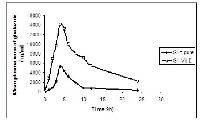Solubility and Bioavailability Improvement of Gliclazide by Solid Dispersions Using Novel Carriers
Keywords:
Solid dispersion, Vitamin E TPGS, Gelucires, FusionAbstract
Solid dispersions (SD) of Gliclazide (Glc); a poorly water soluble drug and Vitamin E TPGS (Vit E), Gelucire 44/14 (Gel44) and Gelucire 50/13 (Gel50) prepared by fusion method. Prepared solid dispersions were subjected for solubility studies in various buffers. Best formulation was selected based on solubility and a fast dissolving tablet was developed, dissolution was performed in 7.4 pH buffer. SD s was characterized by X-RD and DSC. After ageing for three months, fast dissolving tablets were again tested for dissolution. Formulation F3 was selected for in vivo bioavailability study. Solubility and dissolution was proportionately improved for all the formulations with the carrier. X-RD and DSC studies revealed that the crystal nature of the drug has been transformed to amorphous after preparing SD. In vivo study in albino rabbits has justified the improvement of solubility by enhancing the bioavailability of the SD. Vit E TPGS has been proved to be effective in improving the solubility and in vivo bioavailability of Gliclazide.
References
Gillmann AG, Rall TW, Nies AS, Taylor P, In: Goodman and Gillmann’s The Pharmacological Basis Therapeutics. 8th ed., Pergamon, Maxwell House, New York, U.S.A, 1990; 1485‐1486.
Chawdhary KPR, Vijayasrinivas S. Biopharmaceutical classification system. Indian Pharmacist 2004; 2: 7‐10.
Vikas S, Vipin K, Mahesh K, Manoj G, Pratim C. Dissolution Enhancement of Drugs. Part I: Technologies and Effect of Carriers. International Journal of Health Research 2009; 2 (2): 107‐124.
Overhoff KA, Engstrom JD, Chen B. Novel ultra rapid freezing particle engineering process for enhancement of dissolution rates of poorly water soluble drugs. Eur J Pharm Biopharm 2007; 65: 57‐67.
Ahuja N, Katare OP, Singh B. Studies on dissolution enhancement and mathematical modeling of drug release of a poorly water‐soluble drug using water‐soluble carriers. Eur J Pharm Biopharm 2007; 65: 26‐38.
Friedrich H, Fussnegger B, Kolter K, Bodmeier R. Dissolution rate improvement of poorly water soluble drugs obtained by adsorbing solutions of drugs in hydrophilic solvents onto high surface area carriers. Eur J Pharm Biopharm 2006; 62: 171‐177.
Varshosaz J, Talari R, Mostafavi SA, Nokhodchi A. Dissolution enhancement of gliclazide using in situ micronization by solvent change method. Powder Technology 2008; 187(3): 222‐230.
Leuner C, Dressman J. Improving drug solubility for oral delivery using solid dispersions. Eur J Pharm Biopharm 2000; 50: 47‐60.
Duncan QMC. The mechanism of drug release from solid dispersions in water‐soluble polymers. Int J Pharm 2002; 231: 131‐144.
Sharma DK, Joshi SB. Solubility enhancement strategies for poorly water‐soluble drugs in solid dispersions. Asian journal of Pharmaceutics 2007; 1(1): 9‐14.
Asyarie S, Rachmawati H. In vivo and in vitro evaluation of a solid dispersion system of gliclazide: PEG 6000. PDA J Pharm Sci Technol 2007; 61(5): 400‐410.
Neelam S, Mamta K. Micellar Solubilization of Some Poorly Soluble Anti diabetic Drugs: A Technical Note. AAPS Pharm Sci Tech 2008; 9(2): 431‐436.
Khouloud AA, Hussien A, Wafaa YA. Study of the solubilisation of gliclazide by aqueous micellar solutions. Journal of Pharmaceutical Sciences 2003; 92(4): 839‐846.
Aggarwal S, Singh PN, Mishra B. Studies on solubility and hypoglycemic activity of gliclazide betacyclodextrinhydroxypropylmethyl cellulose complexes. Pharmazie 2002; 57: 191‐203.
Hiremath SN, Raghavendra RK, Sunil F, Danki LS, Rampure MV, Swamy PV, Bhosale UV. Dissolution enhancement of gliclazide by preparation of inclusion complexes with β‐cyclodextrin. Asian journal of Pharmaceutics 2008; 2(1): 73‐76.
Patil MP, Naresh GJ. Preparation and characterization of gliclazide‐polyethylene glycol 4000 solid dispersions. Acta Pharm 2009; 59: 57–65.
Biswal S, Sahoo J, Murthy PN, Giradkar RP, Avari JG. Enhancement of Dissolution Rate of Gliclazide Using Solid Dispersions with Polyethylene Glycol 6000. AAPS Pharm Sci Tech 2008; 8 (4) Article 108: E1 – E8.
Betageri GV, Makarla KR. Enhancement of dissolution of glyburide by solid dispersion and lyophillisation techniques. Int J Pharm 1995; 126: 155–160.
Serajuddin, A.T.M., Solid dispersions of poorly watersoluble drugs: early promises, subsequent problems, and recent breakthroughs. J. Pharm. Sci. 1999: 88; 1058–1066.
Khoo, S.M., Porter, C.J.H., Charman, W.N. The formulation of halofantrine as either non-solubilising PEG 6000 or solubilising lipid based solid dispersions: physical stability and absolute bioavailability assessment. Int. J. Pharm. 2000; 205, 65–78.
Bhaskar Chauhan, Shyam Shimpi, Anant Paradkar,Preparation and evaluation of glibenclamide solid dispersions with silicone dioxide by spray drying technique. Eur J Pharm Sci 2005;26: 219-230.
Sethia S, Squillante E, Solid dispersion of carbamazepine in pvp k30 by conventional solvent evaporation and supercritical methods. Int. J.of Pharm., 2004;272:1-10.
Farzana S. Bandarkar, Ibrahim S. Khattab, lyophilized gliclazidepoloxamersolid dispersions for enhancement of invitro dissolution and invivo bioavailability international journal of pharmacy and pharmaceutical sciences, 2011, 3 (2).
Hisham S. Abou-Auda, Saleh A. Bawazir, Yousef A.Asiri, Studies on solubility and hypoglycemic activity of gliclazide B-cyclodextrin complexes, International Journal of Pharmacology, 2006:; 2 (6):656-663.





